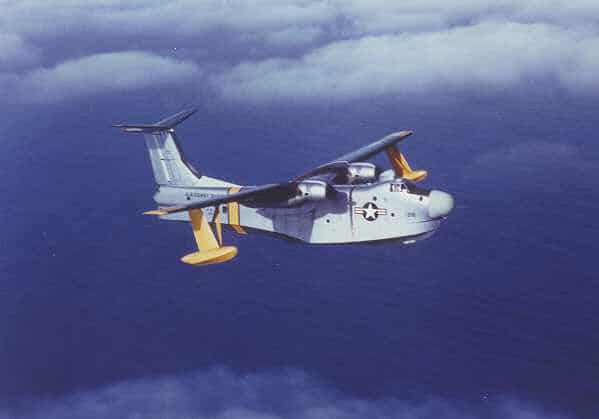
The prototype P5M Marlin was based on the PBM-5 Mariner. The P5M had the same wing but an extensively modified fuselage with a hull that extended the full length of the aircraft. It featured a tall single vertical stabilizer instead of the twin tail fins of the PBM-5 and the horizontal stabilizer featured a strong dihedral. The aircraft featured “hydroflaps” operated by the pilot’s rudder pedals, which could be used as water brakes. The P5M was a pure seaplane. The Navy ordered the P5M into production with changes to the prototype. The hull design was revised; the nose turret was replaced with a radome for an AN/APS -80 search radar; the cockpit was raised; the wing floats were mounted on single wide struts; and the dorsal turret was removed. The tail turret was retained but in actual operation the armament was removed.
The P5M was powered by two Wright R-3350-WA Turbo compound engines fitted into long nacelles. Four JATO bottles could be attached to aid takeoffs. As with the PBM-5, the nacelles had weapons bays that could accommodate two torpedoes or two 2000 pound bombs. Up to 1000 pounds of armament could be carried on underwing pylons. Initial service deliveries of the P5M-1 began in December 1951.
Most P5M-1s were given a comprehensive update in the late 1950s to optimize them for anti-submarine warfare (ASW) with equipment such as an active-passive sonar system; an AN/SQ-8 magnetic anomaly detection (MAD) system; an AN/APA-68 radio direction finding system; a tail-warning radar; and a searchlight mounted under the starboard wingtip.
Martin began a major redesign of the P5M-1 in 1951, producing the P5M-2. The P5M-2 had a distinctive tee tail, with a MAD boom fitted at the junctions of the tailplanes; uprated engines; much greater fuel capacity; the bow chime was lowered to reduce spray and the crew accommodations were improved. This came on line in the fall of 1953.
The Coast Guard acquired seven newly built P5Ms directly from Martin Aircraft in 1954. They were designated P5M-1G. These aircraft were used for search and rescue purposes and did not have ASW gear and defensive/offensive armament. In 1956 four P5M-2Gs, equipped for SAR missions, were purchased by the Coast Guard. Both the P5M-1Gs and P5M2Gs were transferred to the Navy in 1961 due to high maintenance and operating costs. The navy used the former Coast Guard P5Ms as training aircraft.
The following data is for the P5M-2G model:
| Manufacturer | Glen L. Martin | Max Speed | 218 kts |
| Designation | P5M-2G | Cruise Speed | 130 kts |
| Aircraft Type | Seaplane – SAR | Empty Weight | 50,485 |
| Wing Span | 118’ 2” | Gross Weight | 85,000 |
| Height | 32’ 9” | Crew | 3 pilots; seven crewmen |
| Length | 100’ 7” | Service Ceiling | 24,000’ |
| Fuel Capacity | 3,950 gallons | Engines | 3,450 hp R-3350-32 WA |
| Range | 1790 nm | Propellers | 15’ 2’’ Hamilton Standard |

